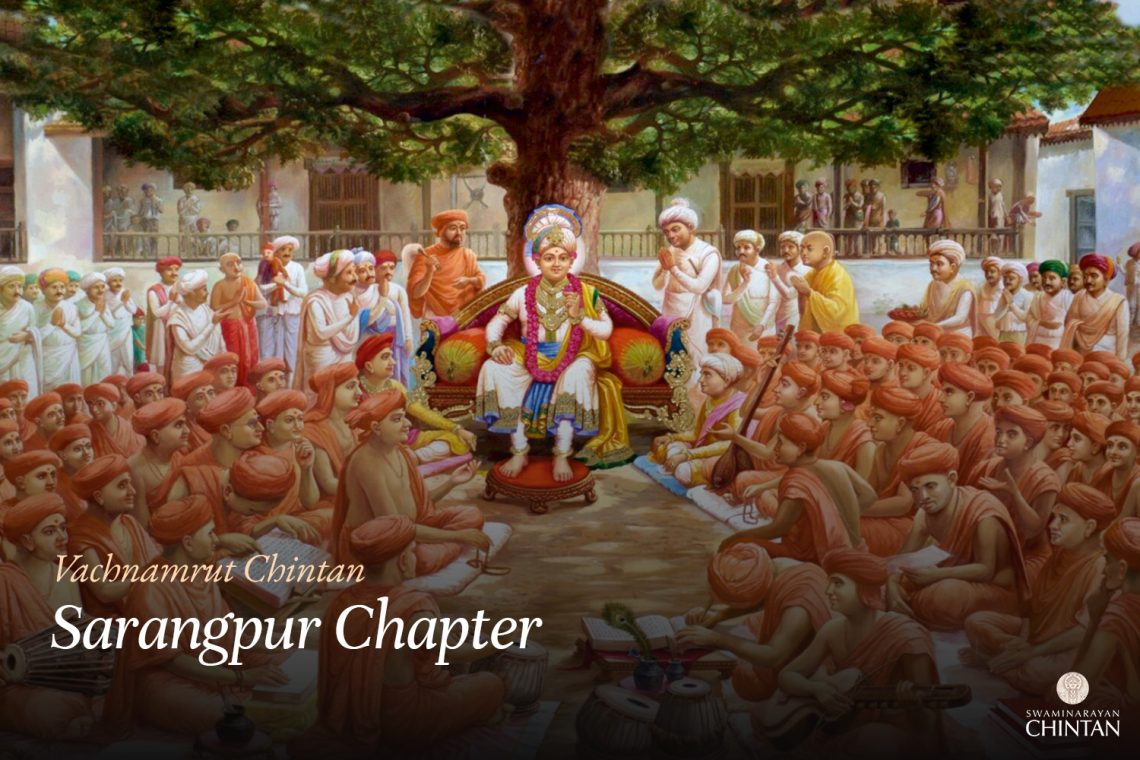Central Insights:
- The two types of people: Dharmi (pious) and Adharmi (evil), and the distinction between Atmadrashti (internal vision) and Bahirdrashti (external vision).
Main Points:
- Those who have love for true Santo are Dharmi. Those who have hatred for true Santo are Adharmi.
- Cultivate a relationship with Maharaj through Atmadrashti.
- Devotees with Atmadrashti are highly revered.
Commentary:
In this Vachanamrut, Maharaj, accompanied by a group of Santo, arrived at the village of Khambhada from Kundal. There, Maharaj addressed the villagers. In this world, there are two types of people: Dharmi and Adharmi. Dharmi people abstain from sins like theft, adultery, slander, and backbiting, fearing God and adhering to their Dharma. They earn the trust of everyone, and their words are considered truthful. Such Dharmi individuals are fond of associating with true Santo. On the other hand, Adharmi people are engrossed in sinful activities like theft, adultery, meat consumption, and drinking alcohol. They are not trusted by anyone, and they dislike the company of true Santo. Instead, they oppose those who associate with Santo. Therefore, those who seek their ultimate good should avoid the path of Adharmi people and seek the company of true Santo by following the path of Dharma, which leads to certain welfare.
In the first canto of the Bhagavat, the sages like Shaunak and others asked, “When Bhagwan, who is the protector of Dharma, departed from this Earth, under whose protection did the Ekantik Dharma remain?” The answer is that Dharma remained under the protection of Santo who upheld the image of Bhagwan and practiced Dharma. Maharaj also said in Vach. Vadtal 14 that even a highly sinful person, who has fallen from the Dharma of caste and ashram, can attain great merit if they harbor virtues of Bhagwan or true Santo in their hearts. Their sins are destroyed, and they become pure, attaining samadhi in Bhagwan. However, if a person observes Dharma but opposes true Santo, the merits of their Dharma are burnt to ashes. True Santo, who practice Dharma, are embodiments of Bhagwan and living symbols of Dharma. Therefore, those who develop love for such Santo will naturally develop love for Dharma.
Maharaj then moved to Sarangpur, where He explained that divine abodes like Golok, Vaikunth, Shwetdweep, and Brahmpur seem distant when perceived through Bahirdrashti but are not even an atom’s distance away when perceived through Atmadrashti. Bahirdrashti is deceptive, while Atmadrashti is true. The proximity of Bhagwan to the soul is twofold: external proximity, experienced during His earthly incarnation, and internal proximity, where Bhagwan always resides within the soul. A Sadhu who firmly believes that Bhagwan resides within their soul and transcends the three bodies (Sthool, Sukshma, and Karan) is not far from Bhagwan or His divine abodes. Such a Sant is equivalent to a redeemed soul of Shwetdweep. Seeing such a Sant is akin to seeing Bhagwan Himself. A person who cannot develop this understanding should steadfastly remain in the company of Santo who have this realization, even if they have to endure rebukes or insults. By steadfastly remaining in their company, they too will attain the same spiritual status as the Santo they associate with.
Hence, Maharaj concludes that the true Atmadrashti relationship with Bhagwan is invaluable and surpasses any external relationship. Atmadrashti brings true and eternal closeness to Bhagwan, beyond the reach of Kala, Karma, or Maya. Therefore, it is rare and precious to attain such proximity to Bhagwan, comparable to a liberated soul in Shwetdweep.
Maharaj says, “If one cannot develop such understanding but remains in the company of the Sant, and even if the Sant reproaches them by beating them with slippers daily, they should endure the insult and, like an opium addict who cannot forsake opium, they should not leave the company of the Sant. Such a person should be regarded as equal to the first Sant mentioned. This means that if one connects with the Sant who is united with Bhagwan, the same connection with the Sant will yield the fruit of connecting with Bhagwan. The Sant is the complete carrier of Bhagwan and not an obstacle. Therefore, the closeness, happiness, bliss, and attainment one achieves by connecting with Bhagwan can also be achieved by connecting with the Sant. Maharaj says that just as an opium addict is bound to opium, and nothing else, not even nectar, can replace it if the addiction is strong, similarly, the bond with the true Sant that Maharaj speaks of is for liberation from the world and attainment of Bhagwan’s abode. Therefore, Maharaj says, the attainment the Sant achieves is also attained by the one who remains in the company of the Sant.”
Glossary
| Dharmi – Pious person |
| Adharmi – Evil person |
| Atmadrashti – Internal vision |
| Bahirdrashti – External vision |
| Ekantik Dharma – Single- minded, holistic devotion A combination of dharma, gyan (knowledge), vairagya (detachment), and bhakti (devotion), leading to liberation. |
| Golok – The divine abode of Bhagwan Krishna |
| Vaikunth – The Divine abode of Vishnu Bhagwan |
| Shwetdweep – The divine abode of Vasudev Bhagwan A celestial abode for those with a high level of devotion. |
| Brahmpur – Akshardham |
| Sthool Sharir – Gross body |
| Sukshma Sharir – Subtle body The inner faculties, such as the mind and intellect, which bind the soul to the material world. |
| Karan Sharir – Causal body The root of the mind’s ignorance and attachment, more dear to the jeev than the gross body. |
| Kala – Time |
| Karma – Action The deeds performed by a Jeev, which determine its future experiences based on the law of cause and effect. |
| Maya – Illusion The material energy that entangles the Jeev in worldly existence and distracts from Bhagwan. |
| Opium Example – Metaphor for spiritual attachment |
| Slipper Beating – Symbolic endurance Maharaj’s teaching that enduring hardships from a true Sant leads to spiritual progress. |
| Ultimate Proximity to Bhagwan – Being close to Bhagwan beyond Maya |

